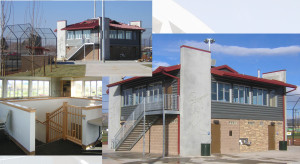 There’s a lot of talk about smart building design and smart building technology. It promises benefits for owners and occupants, energy savings and more. It also poses an interesting set of challenges for the structural engineering team. Smart building or intelligent buildings require the intelligence to be designed into the building from the get-go. Structural engineering has to take into account the elements and connectivity required to achieve intelligence. Fortunately, intelligent building offers some structural engineering benefits, as well.
There’s a lot of talk about smart building design and smart building technology. It promises benefits for owners and occupants, energy savings and more. It also poses an interesting set of challenges for the structural engineering team. Smart building or intelligent buildings require the intelligence to be designed into the building from the get-go. Structural engineering has to take into account the elements and connectivity required to achieve intelligence. Fortunately, intelligent building offers some structural engineering benefits, as well.
What is an intelligent building?
One definition is that smart building combines environmentally sensitive design with networked digital technology to achieve new levels of building automation. Building automation started with automating heating and lighting. Controls that turn off the lights when no one is in the room, and automatically adjust heating and air conditioning to respond to weather conditions and occupancy — these just scratch the surface. Today’s intelligent buildings use a range of sensor technologies, cloud technology, wireless Ethernet (WiFi) and centralized building management software based on apps. The Internet of Things is an important concept — building intelligence and communications capability into what were once considered stand-alone machines and devices. It allows the building managers to monitor and control every part of the building from a central point in real time. The payoff is a more comfortable working or living environment, reduced energy and maintenance costs, a lighter environmental footprint, better integration into the surrounding neighborhood, and a longer and better lifespan.
The elements of intelligent buildings
Smart buildings today incorporate cutting-edge digital technology into every aspect of building control, management and maintenance. Sensors in every part and every phase of the building are connected to centralized monitoring control systems using both wired and wireless networks. Another important part of intelligent building that has a bearing on structural engineering is power over Ethernet. There are three IEEE-approved protocols to distribute electrical power over twisted pair Ethernet wiring. This allows a single cable to provide power and data, and is used to power and connect Voice-over-Internet (VoIP) telephones, IP cameras, wireless network access points, network routers and switches. They can also be used for:
- intercoms, paging and PA systems
- clocks
- industrial control systems
- building access control
- security systems
- Intelligent light fixtures and lighting controllers
- point-of-sale kiosks
Structural engineering challenges
Achieving a smart building requires the architecture, designer, civil and structural engineering, construction— indeed, every phase and entity involved in the building’s life cycle — to incorporate this new technology into the plans. For the structural engineering team, intelligent building requires planning for using IP-based wiring, placing sensors where they’re needed and where they can provide the information to other systems.
Benefits to the building owner
The most obvious benefit of smart building technology and techniques to the building owner are lower costs of structural engineering, building, operation and maintenance. Automating the lighting, heating and air conditioning reduces energy consumption and costs. Just turning off the lights in empty offices has a profound impact that has payoffs for the building owner, the whole economy and community. Centralized control of every aspect of building control and maintenance improves security control and access to the building. Environment and access can be controlled by mobile apps. Intelligent buildings can also send proactive alerts about damage or wear, allowing repairs before the problems get worse. This reduces maintenance costs and extends the lifespan of the building.
Structural engineering payoffs
For the structural engineering team, smart building technology actually provides a number of benefits. The Internet of Things and Power-over-Ethernet can make design, structural engineering and construction faster. Intelligent buildings demand tighter collaboration among all the design and construction teams. IP-based wiring reduces the amount of cabling required, simplifying some of the structural engineering. It also reduces time required for construction and frees up available space for other uses. Talk to our structural engineering team to find out how to incorporate building intelligence into your next project.








